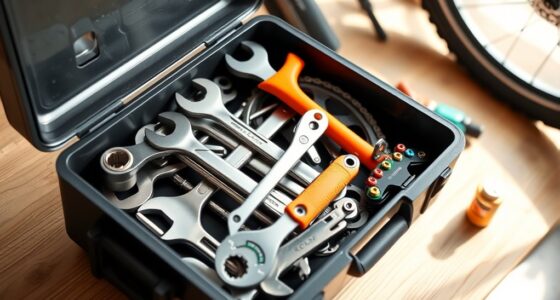When choosing between direct drive and wheel-on trainers, consider your setup and performance needs. Direct drive trainers offer a realistic ride feel and precise power readings but require rear wheel removal, making setup slightly complicated. Wheel-on trainers are easier to use and budget-friendly, but they may lack accuracy and consistency. If you're focused on high-intensity workouts, direct drive could be worth the investment. There's much more to explore, so keep going to find the best fit for you!
Key Takeaways
- Direct drive trainers offer superior accuracy with power readings of +/- 2%, while wheel-on trainers range from +/- 3% to +/- 5%.
- Wheel-on trainers are easier to set up since they don't require rear wheel removal, making them more user-friendly for quick installations.
- Direct drive trainers provide a more realistic riding experience, with smoother performance and less noise, ideal for home use.
- While direct drive trainers are more expensive (ranging from $900 to $1,500), they offer long-term savings through better durability and performance.
- Wheel-on trainers are budget-friendly, priced between $370 and $500, but may require manual calibration for accurate readings and performance.
Overview of Trainer Types

When it comes to indoor cycling, understanding the different types of trainers can greatly enhance your experience.
There are two main options: direct drive trainers and wheel-on trainers. Direct drive trainers connect directly to your bike's drivetrain, offering a more realistic riding experience and providing accurate power readings within +/- 2%. They're quieter and eliminate tire wear concerns, but they tend to be pricier.
Direct drive trainers offer realism and accuracy, connecting to your bike's drivetrain with minimal noise and no tire wear concerns.
On the other hand, wheel-on trainers are generally easier to set up, as you don't have to remove the rear wheel. They're more budget-friendly but may have less accurate power readings, ranging from +/- 3% to +/- 5%.
Smart wheel-on trainers can also connect to virtual riding platforms, adding versatility to your indoor cycling routine.
Ease of Use and Setup

Although both direct drive and wheel-on trainers have their merits, ease of use and setup greatly differ between the two. Direct drive trainers require you to remove the rear wheel for installation, which can be messy and time-consuming. In contrast, wheel-on trainers allow for quicker setup by keeping the rear wheel attached, but they require precise tire pressure and roller tension adjustments, adding to your setup process.
| Feature | Direct Drive Trainer | Wheel-On Trainers |
|---|---|---|
| Setup Complexity | Moderate (cassette required) | Low (clamps onto rear wheel) |
| Bike Switching | User-friendly (no recalibration) | Requires adjustments |
| Maintenance | Minimal | Moderate (tire adjustments needed) |
Riding Experience and Performance

While both trainer types offer unique experiences, the riding performance between direct drive and wheel-on trainers can feel worlds apart.
Direct drive trainers provide a smoother, more realistic simulation of outdoor riding, thanks to their heavy flywheel that eliminates tire slippage. You'll notice how much quieter they are, making them ideal for small living spaces or late-night sessions.
In contrast, wheel-on trainers often suffer from resistance lag and inconsistent power readings due to tire pressure and roller tension, which can hinder your training effectiveness.
Shifting to a direct drive trainer can greatly boost your performance, especially during high-intensity workouts, as their accurate power readings (+/- 2%) enhance your training precision compared to wheel-on trainers' variability.
Accuracy and Data Measurement

Moving from the riding experience to the importance of accuracy and data measurement, you'll find that the differences between direct drive and wheel-on trainers are striking.
Direct drive trainers typically offer power measurement accuracy within +/- 2%, making them more reliable for serious training. In contrast, wheel-on trainers have accuracy ranges of +/- 3% to +/- 5%, often requiring manual calibration.
Direct drive trainers provide power measurement accuracy of +/- 2%, significantly surpassing wheel-on trainers' +/- 3% to +/- 5%.
Factors like tire pressure and roller tension can lead to inconsistencies in power readings, and slippage can cause irregular outputs during workouts. Users of direct drive trainers benefit from greater consistency, as they eliminate variables like tire wear, enhancing training effectiveness.
Ultimately, direct drive models excel in watt measurement accuracy, outperforming wheel-on trainers considerably.
Cost and Value Considerations

When it comes to choosing between direct drive and wheel-on trainers, cost is a key factor that can't be overlooked. Here are some essential points to evaluate:
- Direct drive trainers range from $900 to over $1,500, making them a significant investment.
- Wheel-on trainers are more budget-friendly, typically costing between $370 and $500.
- While direct drive trainers have a higher upfront cost, they can lead to long-term savings by reducing wear on bike components.
- If your training goals include serious indoor cycling, the performance and accuracy of direct drive trainers often justify the expense.
- Additionally, investing in quality equipment can enhance your financial health by potentially reducing future costs associated with repairs and replacements.
Ultimately, weigh the initial costs against the potential value and long-term savings based on your training frequency and goals.
Frequently Asked Questions
Why Are Direct Drive Trainers Better?
Direct drive trainers are better because they offer more accurate power readings, typically within +/- 2%.
You won't have to worry about tire wear or maintenance, as they eliminate the need for a specific indoor tire.
With a heavy flywheel, you'll experience a smoother, more realistic ride, enhancing your training sessions.
They're quieter, making them perfect for indoor use, and swapping bikes is easier without the hassle of recalibration.
What Are the Cons of a Bike Trainer?
Bike trainers can feel like a necessary evil, turning your beloved ride into a stationary contraption.
You'll notice increased tire wear with wheel-on trainers, and your bike maintenance skills might be tested when dealing with direct drive setups.
Noise can be a constant companion, and if you're not careful, inconsistent power readings can turn your workout into a guessing game.
Plus, the initial investment can make your wallet weep.
It's a real balancing act!
What Is the Best Wheel-On a Smart Trainer?
When you're looking for the best wheel-on smart trainer, the Wahoo Kickr Snap often stands out.
It's popular for a reason—offering great compatibility with platforms like Zwift, it enhances your indoor cycling experience.
If you're on a budget, the Tacx Flow is another solid option, providing good features without breaking the bank.
Just remember to use an indoor trainer tire to protect your rear tire during those intense training sessions.
Do I Really Need a Trainer Tire?
You might wonder if you really need a trainer tire for your indoor sessions.
While it's possible to use regular tires, a trainer tire can greatly extend their lifespan by preventing wear and tear from heat and friction.
Plus, trainer tires are designed for better grip and slippage reduction, enhancing your workout experience.
Investing in one now can save you money in the long run by prolonging your outdoor tire's life.
Conclusion
In the battle of direct drive versus wheel-on trainers, you might think the choice is clear-cut. Yet, here you are, standing at a crossroads with options that seem equally enticing—and equally confusing. If you crave convenience, a wheel-on trainer could be your best friend, but if precision's your jam, direct drive might just steal the show. Ultimately, the right trainer is the one that fits your needs, even if that means embracing the irony of overthinking something so simple.









